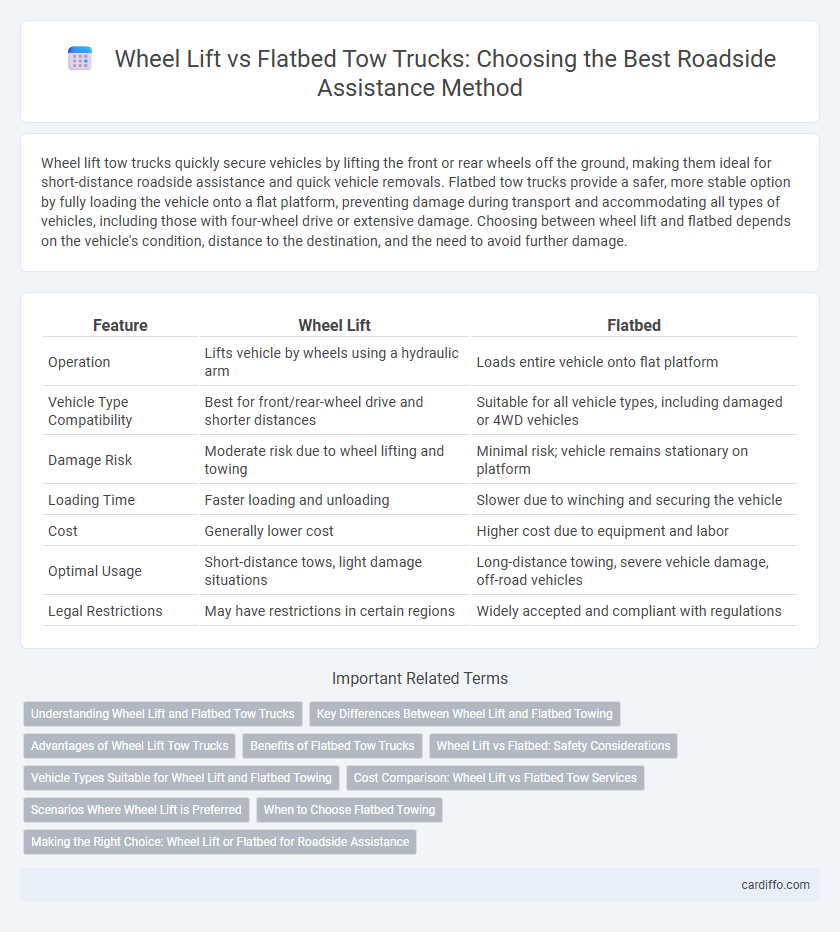Wheel lift tow trucks quickly secure vehicles by lifting the front or rear wheels off the ground, making them ideal for short-distance roadside assistance and quick vehicle removals. Flatbed tow trucks provide a safer, more stable option by fully loading the vehicle onto a flat platform, preventing damage during transport and accommodating all types of vehicles, including those with four-wheel drive or extensive damage. Choosing between wheel lift and flatbed depends on the vehicle's condition, distance to the destination, and the need to avoid further damage.
Table of Comparison
| Feature | Wheel Lift | Flatbed |
|---|---|---|
| Operation | Lifts vehicle by wheels using a hydraulic arm | Loads entire vehicle onto flat platform |
| Vehicle Type Compatibility | Best for front/rear-wheel drive and shorter distances | Suitable for all vehicle types, including damaged or 4WD vehicles |
| Damage Risk | Moderate risk due to wheel lifting and towing | Minimal risk; vehicle remains stationary on platform |
| Loading Time | Faster loading and unloading | Slower due to winching and securing the vehicle |
| Cost | Generally lower cost | Higher cost due to equipment and labor |
| Optimal Usage | Short-distance tows, light damage situations | Long-distance towing, severe vehicle damage, off-road vehicles |
| Legal Restrictions | May have restrictions in certain regions | Widely accepted and compliant with regulations |
Understanding Wheel Lift and Flatbed Tow Trucks
Wheel lift tow trucks use a metal yoke to lift and tow vehicles by their front or rear wheels, making them ideal for short-distance towing and quick roadside assistance. Flatbed tow trucks feature a large, flat platform that fully supports the entire vehicle, providing safer transport for long distances and vehicles with all-wheel drive or damage preventing wheel lifting. Choosing between wheel lift and flatbed tow trucks depends on factors like vehicle type, towing distance, and safety requirements.
Key Differences Between Wheel Lift and Flatbed Towing
Wheel lift towing uses a metal yoke to lift the vehicle by its wheels, making it faster and more efficient for short-distance tows. Flatbed towing secures the entire vehicle on a flat platform, providing greater stability and preventing damage, especially for all-wheel or luxury cars. The key differences lie in the type of vehicle support, towing distance suitability, and the potential risk of vehicle damage.
Advantages of Wheel Lift Tow Trucks
Wheel lift tow trucks offer faster and more efficient vehicle recovery by lifting only the wheels, reducing the risk of damaging the towed vehicle. Their compact design allows better maneuverability in tight spaces, making them ideal for urban roadside assistance. Additionally, wheel lift systems generally require less operator training and are more cost-effective for short-distance towing.
Benefits of Flatbed Tow Trucks
Flatbed tow trucks offer superior vehicle protection by securely transporting cars without dragging, minimizing potential damage to tires and undercarriage. Their versatility enables easy handling of all-wheel-drive, low-clearance, and severely damaged vehicles. Flatbeds also provide enhanced safety during transport, reducing risks associated with road hazards and vehicle instability.
Wheel Lift vs Flatbed: Safety Considerations
Wheel lift tow trucks offer quicker vehicle recovery with less risk of damage to the towed vehicle's drivetrain, enhancing safety during transport. Flatbed tow trucks provide superior stability and prevent tire and suspension wear by lifting the entire vehicle off the ground, minimizing the risk of accidents on uneven or slippery roads. Choosing between wheel lift and flatbed depends on specific towing scenarios, with flatbeds generally recommended for long-distance or heavy-duty towing due to their increased safety features.
Vehicle Types Suitable for Wheel Lift and Flatbed Towing
Wheel lift towing is ideal for light to medium-duty vehicles, such as sedans, motorcycles, and small trucks, because it lifts only the front or rear wheels, minimizing potential damage to the drivetrain. Flatbed towing accommodates a broader range of vehicle types, including heavy-duty trucks, luxury cars, all-wheel-drive vehicles, and those with low clearance, by transporting the entire vehicle on a flat platform. The choice between wheel lift and flatbed towing depends on the vehicle's weight, drivetrain configuration, and susceptibility to damage during transport.
Cost Comparison: Wheel Lift vs Flatbed Tow Services
Wheel lift tow services generally cost less than flatbed towing due to lower equipment expenses and faster loading times, making them a budget-friendly option for standard vehicles. Flatbed tow trucks, while more expensive, offer superior safety and damage prevention for luxury, all-wheel-drive, and heavy vehicles, justifying their higher price point. Understanding the cost variations between wheel lift and flatbed towing helps consumers balance affordability with vehicle protection needs during roadside assistance.
Scenarios Where Wheel Lift is Preferred
Wheel lift towing is preferred in scenarios requiring quick vehicle recovery, such as removing lightly damaged or inoperable cars from congested urban streets. This method excels when towing front-wheel-drive or rear-wheel-drive vehicles without causing damage to the wheels or undercarriage. Emergency roadside assistance providers favor wheel lifts for their efficiency in tight spaces and short-distance transports.
When to Choose Flatbed Towing
Flatbed towing is ideal for vehicles with severe damage, all-wheel drive systems, or luxury cars requiring minimal wear during transport. Selecting a flatbed ensures the entire vehicle is lifted off the ground, preventing potential undercarriage damage common with wheel lifts. This method is preferred for long-distance towing or when the vehicle is immobile or unsafe to be dragged.
Making the Right Choice: Wheel Lift or Flatbed for Roadside Assistance
Choosing between a wheel lift and a flatbed for roadside assistance depends on vehicle type and damage severity; wheel lifts offer quick, efficient towing for standard cars, while flatbeds ensure safe transport for all vehicles, especially those with low clearance or heavy damage. Flatbeds minimize vehicle wear by elevating the entire car, making them ideal for long-distance towing and specialty vehicles, whereas wheel lifts provide faster deployment and are more budget-friendly for short distances. Assessing the specific roadside scenario, vehicle condition, and towing distance will guide the optimal choice between wheel lift and flatbed towing solutions.
Wheel Lift vs Flatbed Infographic

 cardiffo.com
cardiffo.com